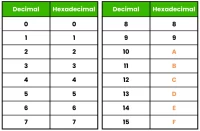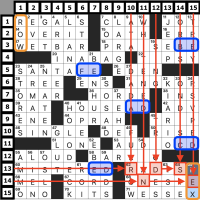 (2.08 avg; 30 ratings) rate it
(2.08 avg; 30 ratings) rate it
Mike Shenk’s Wall Street Journal contest crossword, “Knowledge Base” — Conrad’s writeup.
This week we’re looking for a group of people. There were five horizontal two-word entries:
- PRAISE(BE): [ “Hallelujah!” ]
- SANTA(FE): [ State capital founded in 1610 ]
- HOUSE(AD): [ Self-promotional newspaper spot ]
- AUDIO(CD): [ Bit of concert merch ]
- MISTER(ED): [ Four-legged title character of 1960s TV ]
I noticed that the 2nd word in each themer was two letters long, so I wrote those out separately in my notes. I realized they were comprised of hexadecimal letters, and I looked at the final horizontal entry (where Mike often stashes an extra clue). I noticed HEX, the final vertical entry. I had step one: convert the hex (base 16) letters to decimal (base 10): BE -> 11,14, FE -> 15,14, etc.
Then I spun my wheels for a bit. I tried the usual meta crossword techniques of mapping those numbers back to the numbered grid entries, converting the numbers to the alphabet, etc. No luck. I went back to the grid, hoping Mike stashed a 2nd clue somewhere. I noticed the first horizontal clue: ROW (symmetric with HEX), clued as Column’s follower in a pair of x-axis/y-axis coordinates. I had the rabbit: search for the converted hex coordinates on the 15×15 crossword grid in column, row order:
- BE -> 11,14 ->N
- FE -> 15,14 -> E
- AD -> 10,13 -> R
- CD -> 12,13 -> D
- ED -> 14,13 -> S
The mapped coordinates spell NERDS, our contest solution. I loved this meta by Mike, but I am a giant NERD. Solvers: please share your thoughts.
Postscript: I wrote this up on the plane yesterday while flying home from Europe, saved it as a draft, meant to take a 2nd editing pass and add more, and… fell asleep shortly after getting home. Many commenters here have correctly noticed OVERIT. I was fortunate and spotted the HEX theme before seeing OVERIT. I spotted that entry later, but it was one character shorter than the shortest themer, and didn’t have a symmetric matching entry. That being said: that entry is sloppy, IMO (which is unusual for Mike).


What about the horizontal 2-word entry OVER IT?
That got me as well. I knew the key to the Meta had to relate to hexadecimal numbering, but having “IT” in my mix of 2 letter themer words clouded that whole idea up and I wasn’t able to get to steps 2 and beyond.
Totally agree. I also ruled out hexadecimal numbering because of “IT”. That felt a bit sloppy to me, and I never see that with the meta constructors.
+2
+1
Was “IT” a clue to relate the solution to the IT field?
Never could have solved this one. But on the bright side I learned the word/concept hexadecimal, so I’m got that going for me. Which is nice.
This is an excellent use of that quote (one of my favorites.)
I may have been able to suss this one out as is above, but my printed version of the puzzle had all these X’s in the typeface. I see no mention of that here. For instance the title was KNOWLEDGE BXSE, authored Xy Mike Shenk. Across was spelled Xcross. And all the clues that were multiples of ten started with an X in the grid. For example, 10 down Bleached was printed as 1X Whitened in the answer. Same with 20, 30, 40, 50, 60 and 70 answers. HOLODECK started as 4X and ended in 7X. So I thought it had something to do with X BASE which a quick google showed me is sometimes called STAR BASE because people use an asterisk instead of an X. And since HOLODECK was a Star Wars answer, I looked for other likeminded clues. I was completely stumped. Imagine my surprise this morning to see that the solution had nothing to do with any of that. I would love to know if anyone else had this problem. Thank you Conrad for the explanation.
Created a matrix out of the six six-letter answers the begin with ROW, the first 3 and last 3 across answers, then plotted coordinates suggested by the themers (e.g. (B,E) = (2,5)). Hexadecimals didn’t factor in for me. Solid solve as always, Conrad!
I wonder if it should have been a 16×16 grid.
16 x 16 would only be necessary if you were including zero (“0”). It’s a little ambiguous since we are talking about a grid with coordinates, which would normally involve a zero. But if you think about it as “counting” out the rows and columns, you wouldn’t use the zero, just the characters from 1-9 continuing to A-F. As a different perspective, if this were our normal “base 10” instead of “base 16” (hex), it would probably involve a 9 x 9 grid (again, without the zero). Hope this helps.
I understand all that, but seeing a 16×16 grid might help trigger ‘hexadecimal’ recognition. The unused zero row and column would be irrelevant.
+1
+1
I had to explain this to myself like this: For a point of comparison with something more familiar, base 10 has only 9 digits, unless you count 0 (zero). There is rarely a 0 (zero) column for anything. Zero essentially means starting over; in base 10, a 0 is added to the first digit (1) and means starting over at 10, the 10th count. Then again at 100, 1000, etc.
So, in “base 16” there are only 15 digits (or 9 digits followed by the first six letters to represent 11-15), then “start over” at 16 (base 16’s 10!). That’s the best I can do without spending too much time on it
These crossword constructors are madly clever; they almost always get it right!
Are you implying that the binary system only has one digit?
I find your arguement to be without substance. Zero is a perfectly valid digit — just like the other nine of them.
And as for hexadecimal being obscure (according to someone else), there are many of us (myself included) who learned computer programming in the 1960/1970 era and worked extensively in base 16.
Cool.
Be well.
“DORKS” would have been more appropriate.
Hexadecimal? Shenk can sure come up with some obscure shit.
And there are 6 two-letter horizontal entries… so all elegance and cleverness is ruined.
I thought so, too. Then I thought perhaps the “IT” in OVERIT was a clue that the meta is computer-related.
I didn’t solve it!
Not being a computer NERD, I never would have solved this meta. I thought about wildly guessing and submitting MENSA, and NERDS would have been an equally valid shot in the dark. I did get to the 2-letter “syllable” stage and, due to the HEX clue, tried to combine 6 answers (including IT), but I didn’t make it past that stage. My throw it out there guess of MENSA only had 5 letters, so I gave up. Maybe IT was a clue to relate the answer to the field of info tech? Thanks for teaching me something new! ZD
I saw the 2 letter words and added IT also; This was way too abstruse for me but if enough people got it then it is on me that I didn’t get it.
Ack, I should’ve had it. Recognized A-F as hex numbers but missed the HEX entry (and 15×15 didn’t click); saw the ROW clue/entry later but wasn’t able to return to the HEX idea.
Perhaps an asterisk next to the cluing for the 5 actual themers would have helped. But if you hadn’t any exposure to hex through education or the workplace, this meta was a lost cause.
Got all of the two letters. Got distracted by the five car brands. As a fuzzy studies guy in college I was clueless though I did figure that HEX was important.
Spent a long time before giving up and submitting MENSA without any justification for the guess.
All of this leads to the conclusion that Mike is an evil genius
So i haven’t heard an explanation for IT being there in the grid and not being meaningful to the meta. That is a major problem. I told a colleague that i thought the lack of a matching symmetrical entry was probably a toehold if sussed out. Never got on to the hex trick.
Perhaps the “IT” in OVERIT was a clue that the meta is computer-related.
I didn’t solve it!
I spotted a bunch of AI pairs in the grid (mostly diagonal). When that went nowhere, I abandoned it.
It’s just as well. There’s no way that I ever would have gotten this one.
But at least that explains the presence of the “Four-legged title character of 1960s TV.” Even as a grade-schooler, I thought that show was stupid and unfunny.